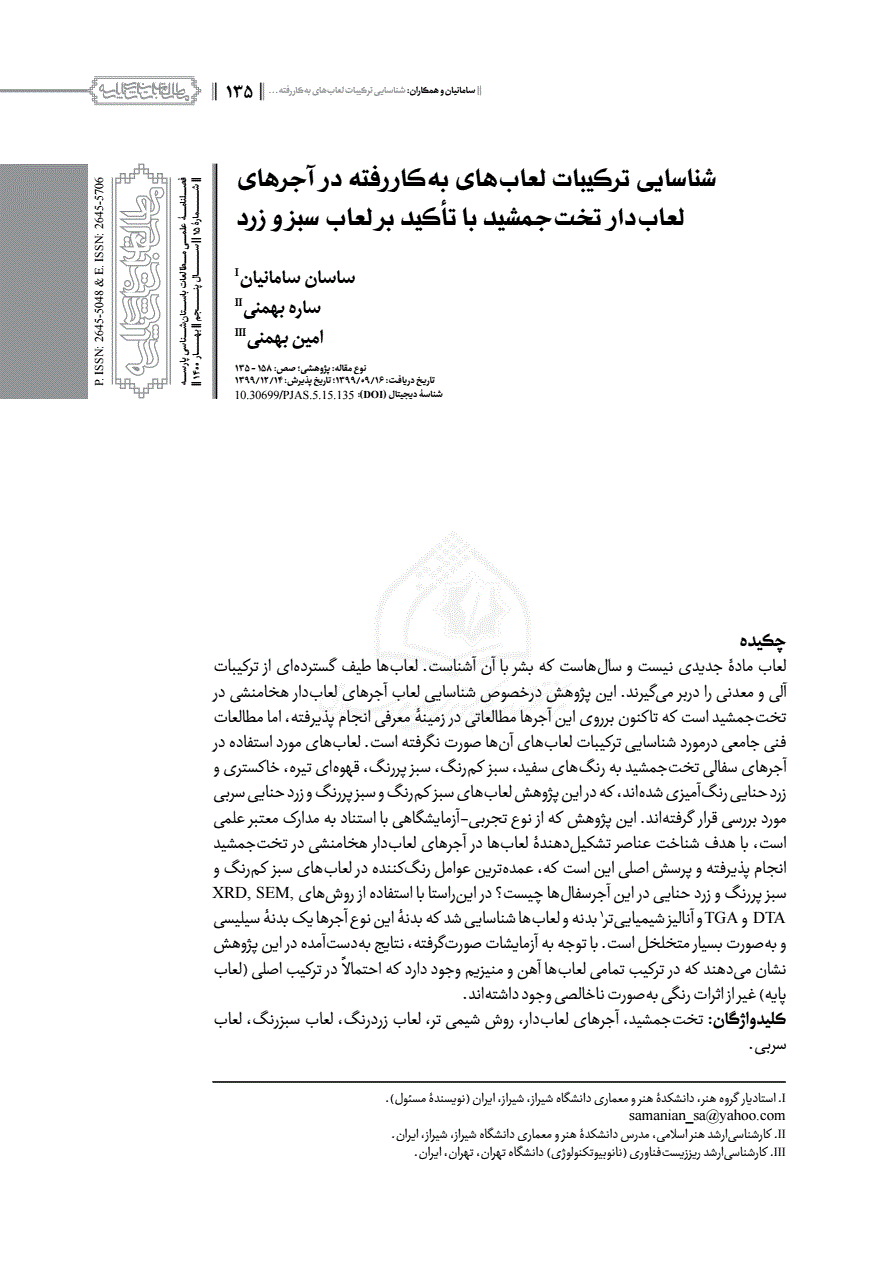چکیده:
لعاب ماده جدیدی نیست و سال هاست که بشر با آن آشناست. لعاب ها طیف گسترده ای از ترکیبات آلی و معدنی را دربر می گیرند. این پژوهش درخصوص شناسایی لعاب آجرهای لعاب دار هخامنشی در تخت جمشید است که تاکنون برروی این آجرها مطالعاتی در زمینه معرفی انجام پذیرفته، اما مطالعات فنی جامعی درمورد شناسایی ترکیبات لعاب های آن ها صورت نگرفته است. لعاب های مورد استفاده در آجرهای سفالی تخت جمشید به رنگ های سفید، سبز کم رنگ، سبز پر رنگ، قهوه ای تیره، خاکستری و زرد حنایی رنگ آمیزی شده اند، که در این پژوهش لعاب های سبز کم رنگ و سبز پر رنگ و زرد حنایی سربی مورد بررسی قرار گرفته اند. این پژوهش که از نوع تجربی-آزمایشگاهی با استناد به مدارک معتبر علمی است، با هدف شناخت عناصر تشکیل دهنده لعاب ها در آجرهای لعاب دار هخامنشی در تخت جمشید انجام پذیرفته و پرسش اصلی این است که عمده ترین عوامل رنگ کننده در لعاب های سبز کم رنگ و سبز پر رنگ و زرد حنایی در این آجرسفال ها چیست؟ در این راستا با استفاده از روش های XRD, SEM, DTA و TGA و آنالیز شیمیایی تر بدنه و لعاب ها شناسایی شد که بدنه این نوع آجرها یک بدنه سیلیسی و به صورت بسیار متخلخل است. با توجه به آزمایشات صورت گرفته، نتایج به دست آمده در این پژوهش نشان می دهند که در ترکیب تمامی لعاب ها آهن و منیزیم وجود دارد که احتمالا در ترکیب اصلی (لعاب پایه) غیر از اثرات رنگی به صورت ناخالصی وجود داشته اند.
Glaze is not a new material and human beings have been familiar with it for many years. Glazes contain a wide range of organic and inorganic compounds. This research is about identifying the glazes of Achaemenid glazed bricks in Persepolis. So far, studies have been conducted on these bricks in the field of introduction, but comprehensive technical studies have not been done on identifying the composition of their glazes. The glazes used in Persepolis clay bricks are painted in white, light green, light green, dark brown, gray and fawn yellow. In this study, light green, light green and yellow fawn glazes were investigated. This research, which is of experimental-laboratory type with reference to valid scientific documents, has been carried out with the aim of identifying the constituent elements of glazes in Achaemenid glazed bricks in Persepolis. What are these bricks? In this regard, using XRD, SEM, DTA and TGA methods and more chemical analysis of the body and glazes, it was identified that the body of this type of brick is a siliceous body and very porous. According to the experiments, the results obtained in this study show that iron and magnesium are present in the composition of all glazes, which may have been present in the main composition (base glaze) in addition to color effects as impurities.

(پژوهیار,
,
,
)

